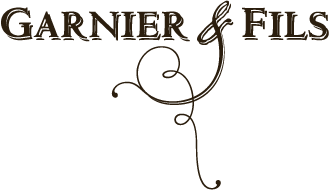2013 Vintage at the GARNIER & sons Wine Estate
Even though our vineyard is at the most northern tip of the Bourgogne region, we were no longer used to harvesting in October. There are a few explanations for this: the growing cycle started late because of a cold and rainy spring. Luckily, warmer and more clement conditions took over, beginning mid-June. From then on, the flowering period went smoothly, in decent conditions but it spread out longer than usual. We then noticed the toil a terrible spring had took. Millerandage* and even complete absence of flowering** largely diminished the harvest.
The grapes grew normally throughout the summer. Disease pressure (mildew and oidium) on the vineyard was reasonable but our minds were still preoccupied by the excellent yet difficult 2012 harvest. It was important to be vigilant. Even if the month of September was perfect for the ripening of the grapes, when it was time to harvest we noticed that yields were low. We saw that the vines had fewer grapes and that, despite the general good health of the vineyard, the grapes had a hard time ripening. The drawn out flowering period caused significant differences in ripening from one parcel to the next.
We had to make some difficult decisions in order not to lose any more of this crop. We slowly started harvesting the 1st of October. Starting on the following Thursday, the 3rd, something rare occurred. The grapes went from being just ripe to over ripe in merely two days with the sudden appearance of noble rot. The affected grapes started “falling to the ground in fear”! With no more time to waste, we sped up the harvest to finish on the 9th of October. Normally, the harvest period lasts 12 days ... Even if the harvest was difficult, the juice that came out of the press was lovely. The first tastings revealed a fleshy and fruity character that comes from the concentration of low yields.
The events of 2013 have come to a close. Like 2012, we have a 30% drop in production for the Estate overall. The problem also concerns our grape supply from other vineyards.
Fermentations have been completed since early February, with as always the sugars that finish after the malolactic fermentation. They will continue evolving for at least another two or three months on their lees without any addition of SO2 since harvest.
We have already prepared the Petit Chablis 2013 as we need fresh, fruity wines that don’t require long maturation. Overall, the wines have nice balance with a very fruity, unctuous character. The aromatic expression tends to notes of candied lemon and apricot while keeping its characteristic Chablis freshness. We might not attain the level of balance of 2012 but it is obvious that 2013 has what it takes to bring grand vins to life.
What’s new?
In our desire to make our wine in large, wood containers, the 2013 vintage has been influenced by the arrival of two 25-hectolitre barrels in our winery. One is made of French oak by the Doreau firm and the other in German and Austrian oak by the Stockinger firm. We have filled them with 2013 Chablis juice from the same provenance before fermentation. Even if right now they both have distinct profiles, they should be quite complementary. We will be sure to keep you informed on their progress while waiting to taste them near the end of 2014.

